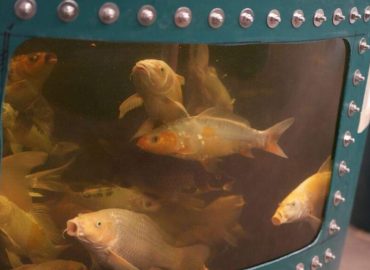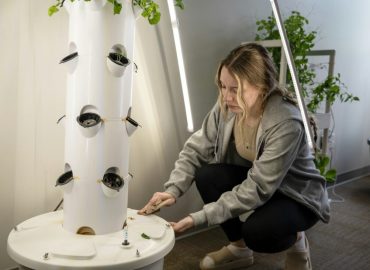Food Recovery Hydroponic Greenhouse
Cranbrook Food Recovery to build hydroponic greenhouse, anticipates high yields
Greenhouse, to be located near Pop Price Park, could grow over 600 heads of lettuce at one time
Food Recovery Hydroponic Greenhouse | Gillian Francis |
IMAGE: Cranbrook Food Recovery coordinator Sophie Larson stands between Healthy Kimberley Food Recovery depot coordinator Shannon Grey-Duncan, on left, and Live for Local representative Christel Hagn, on right. The three women presented at an Ed Talk on food sustainability and accessibility on Sept. 27. Larson mentioned that Cranbrook Food Recovery’s latest project involves building a hydroponic greenhouse to grow food for the people in need (Photo by Gillian Francis)
Cranbrook Food Recovery (CFR), a local volunteer organization that collects unsellable produce from grocery stores to feed people in need, has turned its attention towards urban farming.
The organization has plans to build a hydroponic greenhouse in the parking lot of Pop Price Park to grow fresh produce year-round.
CFR currently collects food from grocery stores that is past its prime, but still edible. Products like dented cereal boxes and cans, and fruits and vegetables that are slightly past the best-before date are collected and then distributed to public bodies like Cranbrook Foodbank Society, Salvation Army, Street Angels, and local schools. The greenhouse would allow CFR to increase the lifespan of its food and the amount that is distributed.
“Right now food recovery is everything that is at the very end of its life and we’re really excited to be like, ‘this was grown and picked here in Cranbrook and now it’s to you next day,’” said CFR coordinator Sophie Larsen.
Now that the location of the greenhouse has been finalized, volunteers have turned their attention to procurement and installation of the unit. The plan is to grow mostly leafy greens and herbs, and Larsen said there should be enough space to grow over 600 heads of lettuce at one time.
“We’ll test out what we grow best and what we need in the community.”
Some of the produce will be sold in order to sustain the greenhouse and some will be given away for free to organizations, who will distribute it to people in need.
Hydroponics is different from traditional farming in the sense that plants are grown using a water-based nutrient solution rather than soil. They are cultivated in little containers with fresh filtered water with a balanced pH. In the absence of soil, materials like vermiculite, perlite, peat moss, coconut fiber and rockwool are used to support the plant’s roots. Hydroponics allows produce to be grown year-round and in any environment, so it eliminates the need for seasonal and climate-specific farming, and weather is no longer a concern. The result, is higher yields with fewer resources.
The hydroponic greenhouse will be manufactured in Manitoba and sent to Cranbrook. CFR has not established a timeline or cost for building yet, but Larsen said there could be a 15-week waiting period between when it is constructed and when they receive it.
CFR plans to hire a farm manager to oversee growing, and there will be opportunities for volunteers as well.
“It’ll be a good learning tool to see different methods of growing food.”
Larsen mentioned the project at a community Ed Talk at the Cranbrook History Centre on Sept. 27; part of a panel of speakers who presented on food sustainability and accessibility. The centre hosts talks on various subjects on the third or fourth Wednesday of each month.
READ MORE: Ed Talks, and counter-factual writing
She also used the event to give a yearly recap on CFR activities. Between March 2022 and 2023, CFR distributed roughly 450 ready-to-eat food servings per week through its Community Meals Program — 95 per cent of which were acquired by food recovery initiatives — and 20,000 cooked meals. It diverted 310,236 pounds of food from the landfill.
Larsen said that despite these high numbers, CFR’s ultimate goal is to lessen food waste, so it would actually like to see the amount of food collected at individual grocery stores reduced. This would involve adding more grocery stores to the collection route, while at the same time, receiving less produce from each one individually.
“We’re hoping that we see a slow decrease in what we get from each location, but at the same time, we want to see more locations donating their food to food recovery. It’s inversely adding more sites to pick up but actually less for each site.”
Original Article: https://www.cranbrooktownsman.com/news/cranbrook-food-recovery-to-build-hydroponic-greenhouse-anticipates-high-yields/
The post Food Recovery Hydroponic Greenhouse appeared first on GROZINE.



